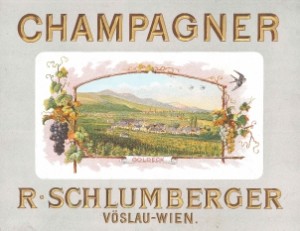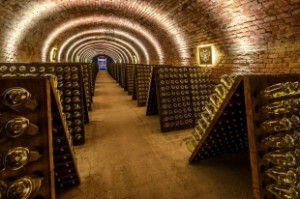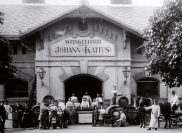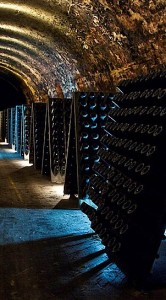Sparkling Vienna
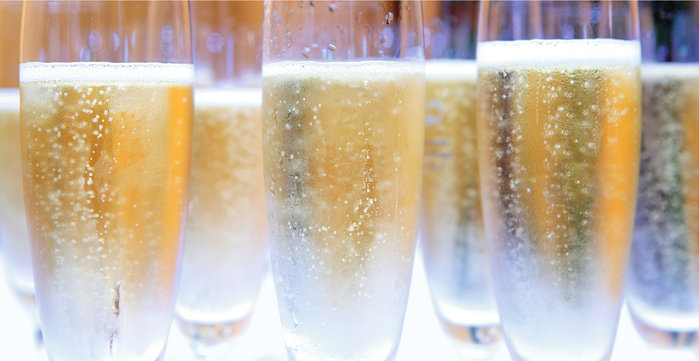
Viennese sparkling wine with tradition
Can you imagine a New Year’s Eve without a glass of sparkling wine? What do you like to clink glasses with when there’s something to celebrate? Sparkling wine and its noble big brother champagne flow like water in this most festive time of the year, and Austria’s new tax on sparkling wine won’t change a thing – after all, when do you otherwise treat yourself to something? The Austrian sparkling wine producers can easily keep up with their international competition, as a kick-off tasting event for Austrian Sparkling Wine Day on October 21, 2014 showed.
Especially in Vienna, sparkling wine production has a long and established tradition. Two producers from Vienna’s 19th District in particular excel through a long history and are quite literally on everyone’s lips.
Schlumberger – how a sparkling wine empire arose from a love story
Born in Stuttgart, Robert Schlumberger learned his trade in Reims, France at the oldest champagne winery Ruinart Père et Fils, where he became head of production. His original plan was to open his own champagne winery in France, when he fell in love with the pretty Austrian Sophie Kirchner while on a ship traveling on the Rhine. Yet Robert Schlumberger could only marry the daughter of a button maker upon promising his Austrian in-laws that the young couple would not move to France. Robert Schlumberger thus leased vineyards in Bad Vöslau, opened a winery in 1842 and specialized in sparkling wine that he produced according to the “method of Champagne.” In the ensuing years he placed the first white sparkling wine on the market. Schlumberger gradually acquired more and more adjacent wineries in the Heiligenstadt area of Vienna as well, which today form the heart of the Schlumberger winery, which produces both wine and sparkling wine.
Schlumberger wines and sparkling wines became a major success and received numerous international accolades starting in 1845. One of his sparkling wines even made it to the British Queen Victoria’s wine list in 1862. Emperor Franz Joseph granted Robert Schlumberger hereditary nobility (as nobleman “Robert Schlumberger von Goldeck”) and named him a royal purveyor to the court. The oldest trademarked brand of wine in Austria also hearkens back to Robert Schlumberger – as the mayor of Bad Vöslau for many years, he created the cuvee “Vöslauer Goldeck.”
Operated by the founding family for four generations, Schlumberger was turned over to Underberg in 1973. It is thereby ensured for the coming generations that Schlumberger will continue to be produced exclusively from Austrian grapes in strict accordance with the “méthode traditionnelle.” Schlumberger has been ISO 9001-certified already since 1994 – the first champagne winery in the German-speaking world to receive this certification. In 2005, the sparkling wine tax in Austria was done away with. In 2007, the innovative sparkling wine creation WHITE Secco offered unique, lightly sparkling, fruity, fresh enjoyment as the Austrian answer to Prosecco. In 2008, Schlumberger GOLD took over the largest segment in the sparkling wine market, the dry segment. In 2009, Schlumberger intensified its focus on its core competencies with its purchase of the Hochriegl champagne winery. Schlumberger remained in Austria as its production location and proclaimed October 22, 2010 the “Day of Austrian Sparkling Wine.” The successful course of innovation also continued. Schlumberger Rosé Secco entered the market in 2011. An entirely new field – consisting of lower alcohol Frizzante – was developed with Hochriegl Frizzante 8.
This year, Schlumberger is celebrating the 200th birthday of its founder Robert Alwin Schlumberger, who was born on September 12, 1814. As a farsighted pioneer, he was convinced of the quality of Austrian grapes as well as the significance of regional value creation already back then.
Kattus – it doesn’t always have to be caviar
At the end of the 18th century, the dynasty founder Johann Kattus moved from Swabia to Austria, where his eponymous son launched his career as a representative for the wine trade. In 1857, Johann Kattus founded a high-end foodstuffs shop at a prime location in Vienna, Am Hof 8, and provided well-heeled customers with select wines, coffee, tea, tropical fruits and champagnes. On one of his many business trips he founded a caviar factory on the Caspian Sea and within no time supplied not only the imperial and princely courts in Vienna and St. Petersburg, but also American economic giants, which made him one of the most significant caviar dealers of his time.
It was not until 1890 that Johann Nepomuk Kattus, the son of the founder, commenced producing sparkling wine. The grapes were from his own vineyards in and around Vienna. From the very beginning, Johann Kattus focused on the strength of the brand – the legendary bottle labels are by the famous artist Franz von Matsch and remain only minimally changed to this day. In 1898, Kattus received from Emperor Franz Joseph the coveted title of royal purveyor to the court.
After the First World War, the three brothers Johann, Josef and Franz Kattus led the company in its third generation through the global economic crisis, the Second World War, as well as the difficult post-war era.
Since 1992, Maria Polsterer-Kattus has been at the helm of the company – now in its fourth generation as a family business – together with her husband Ernst Polsterer-Kattus. That year, Kattus was the first company to introduce Frizzante to the Austrian market. Since then, the portfolio has constantly been expanded with fresh and diverse Frizzantes. Since 2013, Sophie Kattus – the couple’s daughter – has been in charge of the champagne winery’s marketing agenda, thus representing the company’s fifth generation as a family business.
Why Viennese sparkling wine?
What makes the sparkling wine produced in Vienna so special is on the one hand the nearby Weinviertel (lit. “wine quarter”), which provides the outstanding base wines with suitable fruitiness and proper acidity. This is predominantly the Welschriesling grape, although the Grüner Veltliner is meanwhile also used successfully.
On the other hand, the combination of outstanding know-how and well over 100 years of tradition of the wineries located in Vienna naturally counts for something.
In this spirit, celebrate the most festive time of the year, Christmas and New Year’s, and many more celebrations in Vienna – such as the Schick Hotels & Restaurants that are similarly steeped in tradition – and let things sparkle with Viennese or Austrian sparkling wine!
Image credits: © Schlumberger Wein- und Sektkellerei GmbH, Johann Kattus G.m.b.H.


